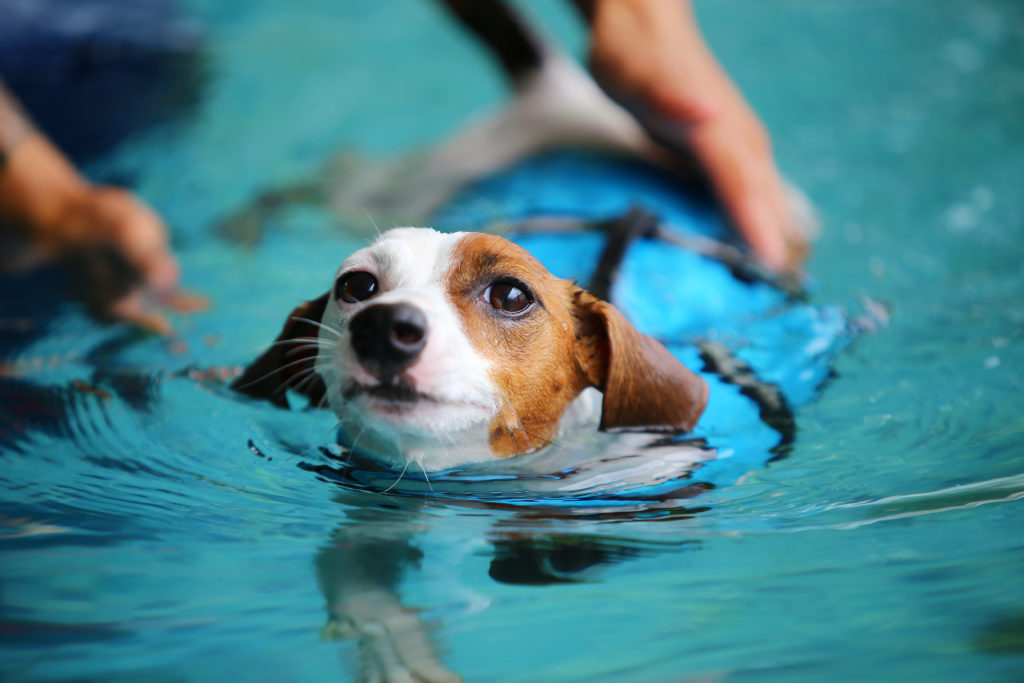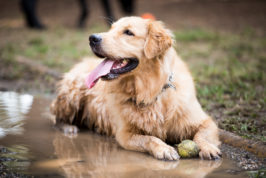We all know how important it is to be a healthy weight, and the same applies to our pets. Being overweight increases the chances of joint issues, diabetes, and cancer amongst other things. If you are reading this then it is likely you are looking for some help to get your dog to shift the pounds, so let’s explore some things that you can try to help your dog lose weight.
How do I know if my dog is overweight?
When vets assess an animal’s weight, they not only pop them on the scales but also give them a body condition score. Your dog will be given a number between 1 to 9, with 1 being severely underweight and 9 being morbidly obese. A score of 4 or 5 indicates your dog is right where he should be, with easy-to-feel ribs and a nipped-in waist when viewed from above. If your dog scores 6 or above, he will need to lose some weight. Discover which dog breeds are prone to being overweight here.
Ways to help your dog lose weight

Weight reduction diets
What do you feed a dog to help him to lose weight? Whilst you can just feed him less of his normal food, the issue is that not only are you cutting calories, but you are reducing the volume of feed they’re getting. This can make some dogs feel quite hungry, leading to more scavenging and begging behaviours. You’re also reducing their vitamin and mineral intake, possibly to below the recommended minimum for their weight.
A prescription weight loss diet is often a better option for weight loss in dogs. The idea behind calorie-controlled diets is that they are lower in energy, but contain increased amounts of fibre which will help your dog feel fuller for longer. This means your dog feels more satisfied compared to drastically cutting his normal diet- so he’s less likely to beg and it’ll be easier on everybody! Feeding his rations split into several small meals rather than one large one can help stop your dog from feeling deprived too. These weight loss diets for dogs often have higher than normal vitamin and mineral amounts so that your dog is still getting his daily allowance.
Many veterinary practices run clinics where staff can talk you through weight reduction diets and discuss your dog’s individual weight loss goals. It is important to measure your dog’s food out accurately each day to keep things on track.
Using weighing scales is much more accurate than using a cup measure – one study found that an 80% over-estimate is possible with measuring cups!
You should also introduce the new diet gradually, mixing it in with his old food over several days.
Low calorie treats
You might be wondering what snacks you can give your dog to help him to lose weight. Ideally, stopping all snacks is best – but it’s not always easy to resist those puppy-dog eyes!
Try to cut back on any treats and titbits given on top of his normal meal rations, including dog treats, dental chews, scraps from the table, or human food. If you can’t cut treats out altogether, then you should look at low-calorie alternatives. Many dogs enjoy raw or cooked vegetables like broccoli, cucumber and carrots, and fruit like blueberries and melon. These should be fed in moderation though, as too many could cause stomach upset.
Puzzle feeders

To help with satiety (the feeling of fullness) puzzle feeders could be used. Putting a dog’s meal in some form of treat dispenser or puzzle feeder helps make them work harder for their food and slows them down. This allows them to ingest the food more steadily, making it last longer and which will help your dog feel more satisfied than quickly gobbling their meal down in one go.
These toys and feeders are also great for mental stimulation, helping to keep your dog busy and encouraging exercise.
Exercise
Increasing the amount of exercise your dog receives can help them burn off some of their excess weight and improves their fitness. However, exercise alone won’t make your dog lose weight, it must be in conjunction with an appropriate diet.
If you struggle to take your dog out for enough walks then it might be worth seeing if friends or family can help, or employing a dog walker. Exercise also helps release endorphins and will make your dog feel happier and more fulfilled, as well as helping him stay trim.
Hydrotherapy

This one can often be overlooked, but hydrotherapy is an excellent alternative way of helping dogs to exercise. Hydrotherapy can be useful for any dog, but particularly those that are severely overweight or that suffer from joint issues. It can also be used to help an old dog lose weight. Normal exercise can be tricky for these animals due to the jarring effect exercising on hard ground can have.
When they are supported in the water, they often find they can move much more freely. This low-impact exercise also provides resistance for dogs to work against to build muscle mass.
Medication
If your dog suffers from joint disease then having him on some form of pain relief can make it easier for him to exercise, which in turn will help with weight loss. Dogs with conditions like Arthritis can slow down, and not be very keen to go for walks. This in turn leads to weight gain, putting further pressure on joints, and leading to more discomfort, and so the cycle continues.
It’s a good idea to start joint supplements for all dogs that are overweight, to help the joints function properly under the extra strain.
For dogs with symptoms of Arthritis, pain relief such as non-steroidal anti-inflammatories can help these dogs break this pattern and start to enjoy exercise again.
Hypothyroidism is a hormonal condition that can affect some dogs, leading to weight gain and lethargy. Medication can help these dogs to improve their metabolism again which can help with weight loss. Whilst we would all love to blame our weight gain on hypothyroidism, it’s not that common – but it’s worth checking in dogs that are struggling to lose weight.
Conclusion
If your dog is overweight, then you will need to take steps to help him get back in shape. Carrying extra weight can lead to other conditions like joint disease, heart problems and cancer, so the sooner you start helping your dog to lose weight the better. Weight loss in dogs needs both tweaks in diet and exercise, as well as management of any other underlying issues. Your veterinarian and veterinary nurse/tech team are there to help support you and can help with achievable targets for your dog.
FAQs
Weight loss should be steady, losing it too quickly can cause problems. It is best to speak with your vet about realistic goals, most dogs are weighed once a month to keep an eye on their progress. In general, a loss of about 3-5% of their body weight per month is a good average.
It may be best to feed your dogs separately if you have one that is on a weight loss regime. This avoids the risk of the overweight dog stealing any of their food, and also means they won’t be teased by what the other animals are eating.
Keeping a food diary can be quite eye-opening. Make sure you and all your family members record every treat and table scrap that your dog receives, as well as his meals. You might soon identify where things have gone wrong!
Dogs with Arthritis have painful joints which can make exercising difficult, contributing to weight gain. You should talk to your vet about the various treatment options available, but broadly speaking joint supplements and anti-inflammatory painkillers can make a real difference for these dogs. Hydrotherapy can be beneficial for Arthritic dogs too, providing a low impact way of exercising as well as boosting their endorphins.
There are no specific supplements that vets currently routinely recommend for weight loss in dogs. If your dog has joint disease, then glucosamine, green-lipped mussel, chondroitin and omega-3-based supplements may help improve their mobility allowing them to exercise more easily. Looking at your dog’s diet is advised, as prescription weight loss foods may be the best way of helping your dog if you are otherwise struggling with their weight.
Dogs need walking all year round, so it’s worth investing in good waterproofs and an umbrella! However, if you can’t get out with them as easily over the winter months it might be worth cutting their rations slightly to allow for the drop in exercise. Consider using puzzle feeders and interactive toys to put their daily kibble rations in as a way of keeping them busy indoors instead.
How long it takes for a dog to lose weight depends on many factors including how overweight your dog is, what diet they are on, and how much exercise they are receiving. Some dogs will naturally lose weight faster than others, as with people. You should be aiming for a steady loss, over a period of around six to eight months depending on how much weight they need to lose.
Dogs need different amounts of food to lose weight, depending on how large they are and what they’re eating. Different diets vary in terms of the quantities they suggest feeding your pet. As a rough guide, you could try cutting your dog’s current rations by 10% and see what effect that has over a couple of weeks, before cutting it again if you need to. Ultimately, a prescription weight loss diet under veterinary advice and supervision may be the best way of helping your pet lose weight correctly.
If they can walk and run well, then there is no reason why you can’t walk an overweight dog as often as you would a normal dog. If your dog is struggling and out of shape, however, then you should aim for 30 mins per day initially with some short periods of brisk leash walking built into this. You should aim to increase the amount of brisk walking you do steadily each week as well as the total amount of time you spend out of the house. You want to gradually aim for 60 minutes of walking per day (ideally spread over two 30-minute walks) with plenty of brisk walking to raise your dog’s heart rate.




